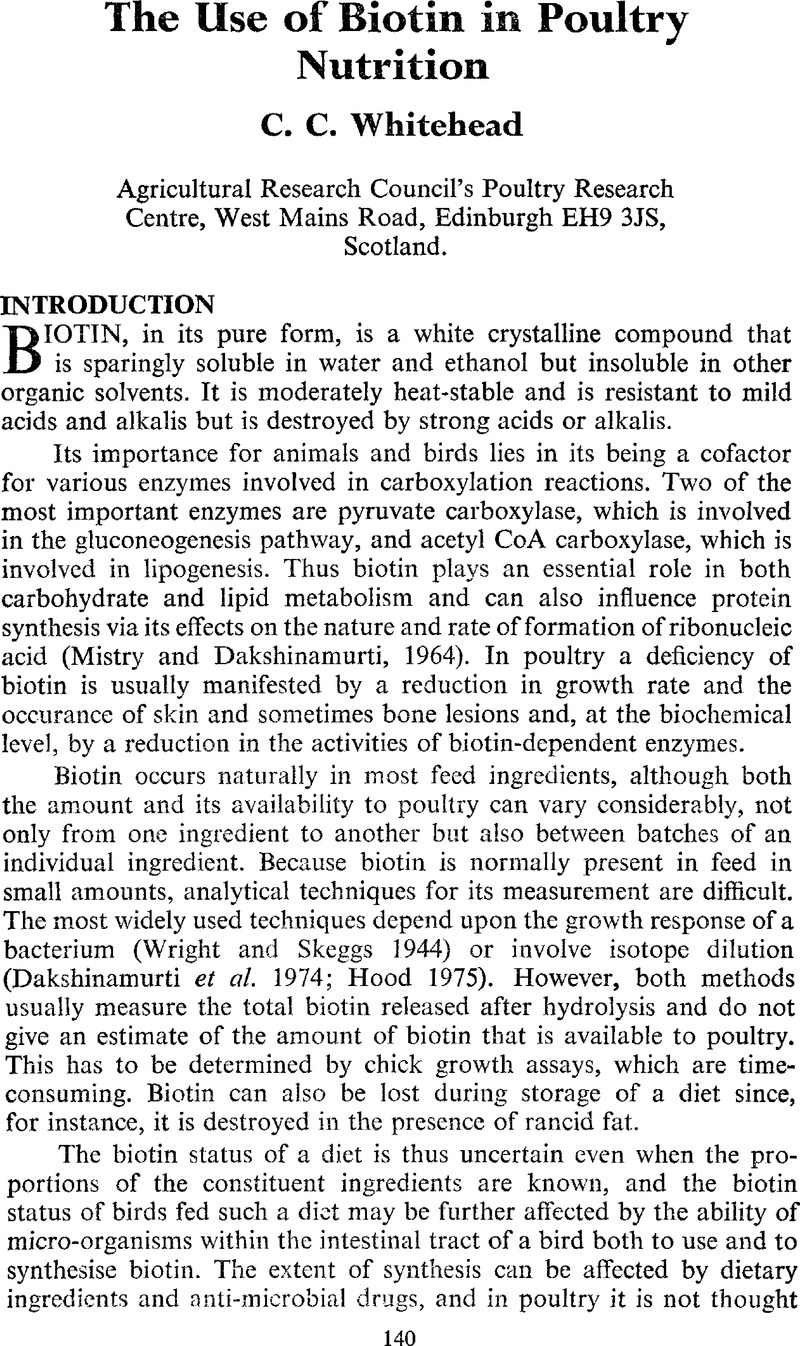Crossref Citations
This article has been cited by the following publications. This list is generated based on data provided by Crossref.
Whitehead, C. C.
and
Bannister, D. W.
1978.
Blood pyruvate carboxylase (EC6.4.1.1) activity as a criterion of biotin status in chickens and turkeys.
British Journal of Nutrition,
Vol. 39,
Issue. 3,
p.
547.
Whitehead, C. C.
and
Bannister, D. W.
1980.
Biotin status, blood pyruvate carboxylase (EC6.4.1.1) activity and performance in broilers under different conditions of bird husbandry and diet processing.
British Journal of Nutrition,
Vol. 43,
Issue. 3,
p.
541.
BURGER, R.A.
ATUAHENE, Y.O.
and
ARSCOTT, G.H.
1984.
Effect of Several Dermatitis Preventing Agents on Foot Pad Dermatitis in Dwarf and Normal Sized Single Comb White Leghorn Layers.
Poultry Science,
Vol. 63,
Issue. 5,
p.
997.
Sauveur, B.
1984.
Dietary Factors as Causes of Leg Abnormalities in Poultry—A Review.
World's Poultry Science Journal,
Vol. 40,
Issue. 3,
p.
195.
ATUAHENE, Y.O.
BERNIER, P.E.
ROUSH, W.A.
and
ARSCOTT, G.H.
1984.
Effect of Biotin on Dermatitis and Hatchability in Dwarf and Normal Size Single Comb White Leghorn Layers.
Poultry Science,
Vol. 63,
Issue. 3,
p.
580.
BURGER, R.A.
and
ARSCOTT, G.H.
1984.
A Cage-Related Foot Pad Dermatitis in Dwarf and Normal-Sized Single Comb White Leghorn Layers.
Poultry Science,
Vol. 63,
Issue. 8,
p.
1512.
WATKINS, B.A.
and
KRATZER, F.H.
1987.
Tissue Lipid Fatty Acid Composition of Biotin-Adequate and Biotin-Deficient Chicks.
Poultry Science,
Vol. 66,
Issue. 2,
p.
306.
Bryden, W.L
1988.
Circulating levels of biotin in the fowl (Gallus domesticus): Modulation by oestrogen.
Comparative Biochemistry and Physiology Part A: Physiology,
Vol. 91,
Issue. 4,
p.
773.
Bryden, W. L.
1989.
Intestinal distribution and absorption of biotin in the chicken.
British Journal of Nutrition,
Vol. 62,
Issue. 2,
p.
389.
Bryden, Wayne L
Mollah, Yasin
and
Gill, R J
1991.
Bioavailability of biotin in wheat.
Journal of the Science of Food and Agriculture,
Vol. 55,
Issue. 2,
p.
269.
WANG, G.
EKSTRAND, C.
and
SVEDBERG, J.
1998.
Wet litter and perches as risk factors for the development of foot pad dermatitis in floor-housed hens.
British Poultry Science,
Vol. 39,
Issue. 2,
p.
191.
Mayne, R.K.
2005.
A review of the aetiology and possible causative factors of foot pad dermatitis in growing turkeys and broilers.
World's Poultry Science Journal,
Vol. 61,
Issue. 2,
p.
256.
Mayne, R.K.
Hocking, P.M.
and
Else, R.W.
2006.
Foot pad dermatitis develops at an early age in commercial turkeys.
British Poultry Science,
Vol. 47,
Issue. 1,
p.
36.
Mayne, R.K.
Else, R.W.
and
Hocking, P.M.
2007.
High dietary concentrations of biotin did not prevent foot pad dermatitis in growing turkeys and external scores were poor indicators of histopathological lesions.
British Poultry Science,
Vol. 48,
Issue. 3,
p.
291.
Youssef, I. M. I.
Beineke, A.
Rohn, K.
and
Kamphues, J.
2012.
Influences of increased levels of biotin, zinc or mannan‐oligosaccharides in the diet on foot pad dermatitis in growing turkeys housed on dry and wet litter.
Journal of Animal Physiology and Animal Nutrition,
Vol. 96,
Issue. 5,
p.
747.
Abd El-Wahab, A.
Radko, D.
and
Kamphues, J.
2013.
High dietary levels of biotin and zinc to improve health of foot pads in broilers exposed experimentally to litter with critical moisture content.
Poultry Science,
Vol. 92,
Issue. 7,
p.
1774.
Sun, Z. W.
Fan, Q. H.
Wang, X. X.
Guo, Y. M.
Wang, H. J.
and
Dong, X.
2017.
High dietary biotin levels affect the footpad and hock health of broiler chickens reared at different stocking densities and litter conditions.
Journal of Animal Physiology and Animal Nutrition,
Vol. 101,
Issue. 3,
p.
521.



